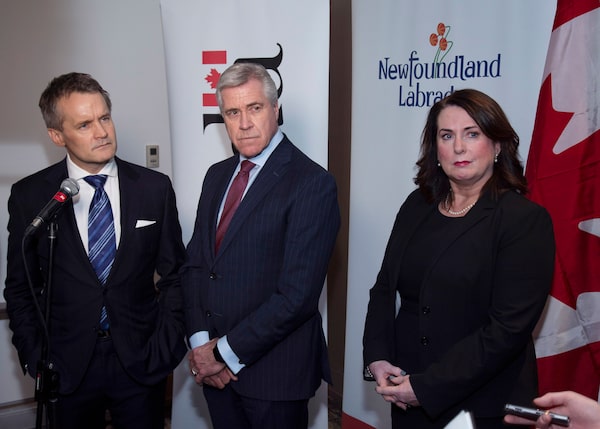
On Monday, federal Natural Resources Minister Seamus O’Regan, left, and his Newfoundland counterpart Siobhan Coady, right, seen here on Feb. 10, 2020 with Newfoundland and Labrador Premier Dwight Ball, announced that the two governments would renegotiate the loan guarantee agreement in what appears to be the prelude to a wholesale bailout of Muskrat Falls.Paul Daly/The Canadian Press
It would be easy to fault Prime Minister Justin Trudeau’s government for coming to the rescue of Newfoundland and Labrador as the province teeters on the financial precipice. After all, Newfoundland got itself into this situation by diving into the ruinous Muskrat Falls hydroelectric project when anyone with a calculator knew it was only asking for trouble.
Now, as sure as the tide comes in, one Liberal government is trying to rescue another with a promise to renegotiate the agreement that allowed for this folly to proceed in the first place when Ottawa guaranteed the debt Newfoundland borrowed to build Muskrat Falls.
Oh, wait, it wasn’t Liberals who created this mess, was it? Prime minister Stephen Harper’s Conservatives stepped up in 2012 to provide a $5-billion loan guarantee for Muskrat Falls, which had been championed by Newfoundland Progressive Conservative premier Danny Williams and his successor in office, Kathy Dunderdale. That was the same Mr. Harper who, in 2002, blamed Atlantic Canada’s “culture of defeat” on interventionist Liberal policies.
Muskrat Falls “will create jobs and economic growth for people in Atlantic Canada, while substantially reducing greenhouse gas emissions,” Conservative natural resources minister Joe Oliver, a self-proclaimed advocate of free markets, said in announcing the 2012 package. “The federal loan guarantee will not only provide a stable source of clean energy for the region, but will also save over $1-billion for ratepayers in Newfoundland and Labrador and Nova Scotia.”
Within months, the original cost estimate of $6.2-billion for Muskrat Falls was thrown out the window and replaced by a succession of ever-escalating estimates before settling on the current $12.7-billion price tag. Construction of the 824-megawatt hydro project on the Lower Churchill River in Labrador and underwater transmission line to Newfoundland was well-advanced when Mr. Trudeau’s government topped up the original loan guarantee by an additional $2.9-billion in 2017, putting Canadian taxpayers further on the hook.
On Monday, federal Natural Resources Minister Seamus O’Regan and his Newfoundland counterpart Siobhan Coady announced that the two governments would renegotiate the loan guarantee agreement in what appears to be the prelude to a wholesale bailout of Muskrat Falls. The first step involves a change in the accounting method Newfoundland had been using to calculate financing costs for Muskrat Falls, moving from an unconventional practice that low-balled upfront payments to a more conventional one that results in higher upfront costs.
Had Newfoundland adopted conventional accounting methods from the outset, the case for Muskrat Falls would have been even dicier than it already was back when Mr. Williams was touting the project as a “great investment.” The provincial demand projections on which Muskrat Falls was based were grossly inflated, as was the potential for export revenues.
The result was that, until Monday’s announcement, Newfoundland consumers were facing a 75-per-cent rise in electricity rates once Muskrat Falls was up and running in 2021. The increase from about 13.5 cents per kilowatt-hour to 23 cents would have devastated low-income households and driven the province’s already struggling economy further into the ditch by threatening the operations of industrial power users such as Vale and Teck Resources.
For months, Liberal Premier Dwight Ball has been promising to unveil a “rate mitigation” plan that would spare the province’s power consumers from having to bear the cost of the previous government’s Muskrat mistake on their electricity bills. With his adoption of a more realistic accounting method, Ottawa has agreed to come to the table to negotiate an aid package.
A deal between the two governments will likely see Canadian taxpayers subsidizing electricity rates in Newfoundland to the tune of hundreds of millions of dollars a year for decades to come. Newfoundland has agreed to look into “monetizing” assets related to Muskrat Falls, including the Labrador-Island Link underwater transmission line, to help offset electricity rate increases. This likely involves borrowing from investors against future transmission revenues.
Newfoundland will also work to convert buildings in the province from oil furnaces to electric heating, which would increase electricity demand and, hence, revenues from Muskrat Falls. But the proceeds won’t be close to enough to prevent electricity rates from skyrocketing. The bulk of the rate mitigation efforts will inevitably fall on Canadian taxpayers’ shoulders.
What other option is there? Canadian taxpayers are on the hook one way or another, due to the loan guarantees. And without an annual rate subsidy from Ottawa, Newfoundland might have to default on Muskrat Falls’s debt.
“Federal policy is working in a way that this region will never succeed,” Mr. Harper said of Atlantic Canada in 2004. “We have to change those policies.”
Did he ever. He made them worse.
 Konrad Yakabuski
Konrad Yakabuski